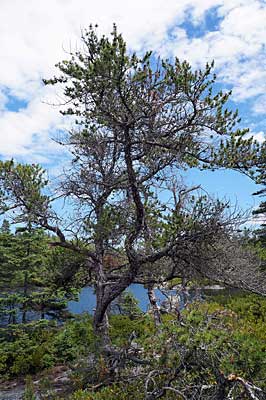Halifax Field Naturalists
Purcell's Cove Aug. 18, 2012 |  Signs at trailhead, just off Purcell's Cove Road (close to civic No 601)
Click on images for larger versions |
SECTION C - D (Not Burnt)
 Jack Pines on outcrops by Purcell's Pond, south side, make for very picturesque settings. (Photo July 26) |
 Jack Pine barrens on higher outcrop (44.604230 -63.576222). Ground vegetation is predominantly Black Huckleberry and Broom Crowberry. Right: Broom Crowberry and Reindeer Lichen: common associates. Broom Crowberry is an Atlantic Coastal Plain species with healthy populations only in Nova Scotia. However, they are diminishing due to development, not in PCCL! |

|
 False Holly (Mt. Holly) in a more moist area; it's deciduous. |
 "Bob's Inkberry". Inkbury is an evergreen holly. It's an Atlantic Coastal Plain species most common in the SW part of NS. There is just one small patch of inkbury on the PCCL trail. (44.603390 -63.577382) |
SECTION D-E (Burnt)
 | Beginning of first burnt area as we walk towards Flat Lake. (44.602940,-63.577742 ) |
SECTION E-F (Not Burnt)
SECTION F-G (Burnt)
SECTION G-H (Not Burnt)
 Low, wet area between high barrens. In photos, Black Spruce, Red Maple, sedges (above); Wood Aster (right, above); Witch-hazel (right, below). |
 
|
SECTION H-J (burnt)
 Drought-stressed lowbush blueberry - leaves senescing while in full fruit. |
 A large patch of Mountain Sandwort; much of it has been drought-killed. |
AREA J (Wetland bordering Flat Lake)
 The wetland immediately adjacent to the lake was largely spared from the fire, but note burnt trees just a little above it, also burnt trees of the other side of the lake. View Photo on May 15, 2009. |
 Rubus hispidus, a creeping blackberry. |
 Tawny Cotton Grass |





















